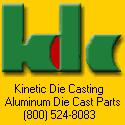Basically, heat sinks are used to reduce the amount of heat in electrical appliances. Heat sinks have been used to prevent overheating and breakdown of the concerned appliance since long, but aluminum heat sinks are a new advancement. Aluminum is …
Continue reading
Category Archives: Diecasting Process
Die casting and its effect on the world
Die casting and its effect on the world. In recent years, metal has started being used every day. From PCs to TVs and refrigerators, almost every invention created by scientific research is made out of metal.
With its pliability and conductivity properties, it was not a challenging task for early humans to learn a way to use it: through fire. Ultimately, the technology of metal casting (pouring molten metal into a mold) became the normal for “sculpting” implements out of this element. One of the mutual processes diverging out from this is die casting, or the use of a mold cavity to guide molten metal into shape.
The most stress-free method of doing this is zinc die casting. Parts of zinc appliances and even accessories can be finished using zinc die casting. It is the most common procedure because zinc is not tough to handle. Moreover, it produces sturdy materials which are conducive to power and high temperature. Zinc is also high in ductility, which makes it a great material for various products.
In the process of zinc die casting, parts usually include either a hot-chamber die cast or a cold-chamber die cast (reliant on the requirement of the producer) and zinc (or an alloy). The metal is heated to its boiling point. The subsequent liquid is then dispensed into the mold and will take the shape of said mold.

Really, the processing of metal into a pliable creation is an astounding invention – it would accurately shape the future of the world. Zinc die casting, amid others, has aided making the world an easier place to live in.
Do you need fast delivery for die casting parts? Kineticdc shipped parts that were die castings with impregnation, chemical filmed and machined in less than two weeks from receipt of a purchase order. Know someone that wants to buy die cast parts and can use our die casting services?

Call us and let us know 818-982-9200.
Kinetic Die Casting Company 6918 Beck Avenue North Hollywood California 91605
www.kineticdc.com #diecasting #kineticdc #manufacturing @kineticdc
Kineticdc makes:
Automotive Die Casting Parts
Light Fixture Die Casting Parts
Consumer Products Aluminum Parts
Aerospace Die Casting Parts
Military Die Casting Parts
Source For Aluminum Die Casting Parts
Do you need a source for aluminum die casting parts? Know someone that wants to buy die cast parts and can use our die casting services?

Call us and let us know 818-982-9200.
Kinetic Die Casting Company 6918 Beck Avenue North Hollywood California 91605
www.kineticdc.com #diecasting #kineticdc #manufacturing @kineticdc
Like us on FaceBook https://www.facebook.com/kineticdc
Kineticdc makes:
Aircraft Die Castings
Aluminum Heat Sink Die Castings
Automotive Die Casting Parts
Die Casting Bracket Parts
Light Fixture Die Casting Parts
Enclosure Box Die Castings
Consumer Products Aluminum Parts
Aerospace Die Casting Parts
Die Casting Golf Parts
Aluminum Die Casting Capabilities
Kinetic Die Casting Company uses aluminum die casting to product parts, here are some capabilities.

http://www.kineticdiecasting.com/capabilities.html
Die casting is a process that involves creating metal parts. This is achieved by forcing molten metal under high pressure into a mold or die cavity. It greatly reduces the need for further post-production processing by producing high quality surfaces, among other things. Most of the tools and products that people use are produced through this process.
There are different materials used for die casting. One of the most commonly-used materials for this process is aluminum. Aluminum die casting is often used for producing automobile parts and gears and surgical equipment. It is also the preferred material for networking and telecom infrastructures and equipment.
Among other things, aluminum die casting alloys are lightweight. They have a minimum section thickness of 0.89 mm (0.035 in) and a minimum draft of 1:100. In spite of their being a lighter material, they nonetheless belong to the stronger and harder types. They have an ultimate tenile strength that ranges from 40.5 to 48/ksi and the hardness is between 80-120 HB. The melting range is approximately from 960-1200 degrees Fahrenheit, making them among the most durable when subjected to extremely high temperatures.
Aluminum die casting alloys are rustproof, non-staining, and have a high conductivity percentage at 55.6-78.6/Btu/fthr.F (thermal) and 23-31% (electrical) per IACS standard. They are most ideal for complex shapes and thin walls and for most electronic applications. Since most aluminum-based alloys are made from 95% recycled materials, their use contributes a lot to the promotion of green technology.
Summing it up, aluminum-based alloys offer an efficient, cost-effective, and nature-friendly material for developing and improving products and tools that help make people’s lives easier and more productive.
This is the blog on the Kinetic Die Casting Company web site. We make several types of Aluminum Die Casting Capabilities. Look at this website page for more details: http://www.kineticdiecasting.com/capabilities.html. Contact Kinetic Die Casting Company at 818-982-9200 or email us at sales@kineticdc.com. Use this webpage to request “die casting part prices” www.kineticdiecasting.com/replyform.html
Color Your Concrete Roof Tile
Color Your Concrete Roof Tile. The most important artistic part of your home is your roof. The best way to enhance the beauty is by choosing the best color to compliment your house. The most widely used color for roof tile is Terra Cotta. Because of the improvement of technology in roofing, several different types of roofing tiles are introduced to the consumers. Therefore, there are several options for you when picking your roofing tiles.
There are several different varieties of concrete roofing tile colors. There are two methods commonly used to color roof tiles—painting and color-through. Using paint, you can make the roof tiles look like wood, slate, or clay tiles. Furthermore, you can use colors like tan, brown, cream and black if you want it neutral. Using color-through, color pigment is added to the concrete mix to make tiles more durable with color. Also you can have one color or multi-color tiles to give you even more options with your concrete tiles. For instance, you can use different shades of blue or brown to make your roof more beautiful.
One must consider the climate when choosing concrete roof tile colors. The best option for cold climates is color-through. Look at the color of your home before picking out the color of your roof tiles. Roof tiles are one of the best ways to add your own flare to your home. There are endless choices when you come to concrete roofing tile colors.
This is the blog on the Kinetic Die Casting Company web site and talks about the various Aluminum Parts Manufacturing. Look at this website page for more details: http://kineticdiecasting.blogspot.com/. Contact Kinetic Die Casting Company at 818-982-9200 or email us at sales@kineticdc.com. Use this webpage to request “die casting part prices” www.kineticdiecasting.com/replyform.html
Supplementary Technical Die Casting Terms
Supplementary Technical Die Casting Terms. You must probably learn the most common technical die casting terms with your exposure with the die casting manufacturing industries. To widen your knowledge, here’s a set supplementary terms for your perusal.
Alloy
It is a substance composed of two or more metallic elements used predominantly in die casting products.
Anodize
It is a chemical process characterized by coating metals with protective oxide layer. This process is used particularly with aluminum metals.
Clamping Force
It is the actual compressive force applied to keep the die halves closed in a die casting machine.
Cold Shut
This is an undesirable feature in a die casting, usually a line on the surface of the die cast item. This is the effect when the two halves die are not properly aligned.
Creep
It is the plastic or elastic deformation of metals when held for long period and where pressure is applied in a degree that is lower than yield strength.
Creep Strength
When metals withstand a constant force over an increasing degree of temperature, such characteristic is called Creep Strength.
Die
This tool shapes the molten metal into a particular form until it hardens. It molds liquefied metallic substance until it takes the solid form. It is a matching steel block with hollow interiors and a cavity.
Die Block
It is a huge steel block forming the base for one half of the die. Other components of the die are attached to or mounted on it.
Platen
It is a large steel plate that forms a primary part of a die casting machine frame.
This is the blog on the Kinetic Die Casting Company web site. Kinetic does Aluminum Auto Parts Manufacturing. Look at this website page for more details: www.kineticdiecasting.com/auto.html. Contact Kinetic Die Casting Company at 818-982-9200 or email us at sales@kineticdc.com. Use this webpage to request “die casting part prices” www.kineticdiecasting.com/replyform.html

